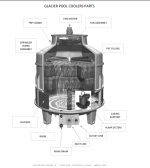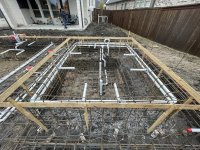For a 2” pipe at 45 GPM, the head loss is 3.4 feet per 100 feet of pipe or 0.034 feet head loss per foot of pipe.
If they specify 25 feet for the distance, then that is 25 x 0.034 = 0.85 feet of head loss.
For 2.5” PVC pipe, the head loss is 0.014 feet head loss per foot of PVC pipe.
0.85/0.014 = 60.7 feet.
So, if the distance is limited to 25 feet with 2” pipe, the distance limit for 2.5” pipe is about 61 feet.
The Total Equivalent feet is the length of the straight pipe plus about 5 feet for a hard 90 or about 3.5 feet for a sweep 90.
For example, if the plumbing is 40 feet plus 5 sweep 90s, then the total equivalent length is 40 + (5 x 3.5) = 57.5 feet.
You would need the pump performance chart to know the actual flow vs. head loss.
Below, you can see the performance of two different submersible pumps vs. the head loss.
The rated flow maximum of 1,745 gph ( 29.1 gpm) happens at 0 head loss.
Typically, a pump like that will operate in the 5 to 15 foot head loss range, so the limits of 0.85 feet of head loss seem way too low.




If they specify 25 feet for the distance, then that is 25 x 0.034 = 0.85 feet of head loss.
For 2.5” PVC pipe, the head loss is 0.014 feet head loss per foot of PVC pipe.
0.85/0.014 = 60.7 feet.
So, if the distance is limited to 25 feet with 2” pipe, the distance limit for 2.5” pipe is about 61 feet.
The Total Equivalent feet is the length of the straight pipe plus about 5 feet for a hard 90 or about 3.5 feet for a sweep 90.
For example, if the plumbing is 40 feet plus 5 sweep 90s, then the total equivalent length is 40 + (5 x 3.5) = 57.5 feet.
You would need the pump performance chart to know the actual flow vs. head loss.
Below, you can see the performance of two different submersible pumps vs. the head loss.
The rated flow maximum of 1,745 gph ( 29.1 gpm) happens at 0 head loss.
Typically, a pump like that will operate in the 5 to 15 foot head loss range, so the limits of 0.85 feet of head loss seem way too low.


















